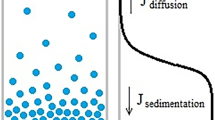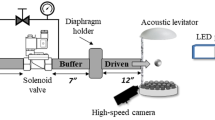Abstract
Vapor-to-liquid phase change in the form of discrete drops on or underneath a substrate is called dropwise condensation. The process is hierarchical in the sense that it occurs over a wide range of length and timescales. As the associated heat transfer coefficient is much higher than the film and mixed mode of condensation, it is of considerable interest in applications. The present study is focused on mathematical modelling of dropwise condensation process at multiple scales. The model includes formation of drops at the atomistic scale, droplet growth, coalescence, instability, slide off and fall-off, followed by fresh nucleation of liquid droplets. The model shows that the largest stable cluster size in the atomic model matches the minimum drop radius estimated from thermodynamic considerations. The minimum drop radius is insensitive to surface texturing and does not provide controllability at larger length and timescales. A closer examination of droplet distribution over the substrate reveals that small drops are locations of high heat transfer rates, which diminishes with increasing drop radius. The largest drop diameter depends on its stability and hence, the interfacial forces at phase boundaries. Therefore, drop instability controls the heat transfer coefficient in dropwise condensation. Enhancement of heat transfer necessitates that these drops grow with time, become unstable and be swept away as quickly as possible. Enhancement may be achieved either by (i) inclining the substrate or (ii) by creating an interfacial force at the three-phase contact line by a wettability gradient over the horizontal substrate, inducing drop motion. Wall heat transfer and shear stress under moving drops have been determined using a CFD model. A simple model of coalescence has been adopted in this work. Simulation studies on the effect of fluid properties, surface inclination and its wettability condition on drop size distribution, cycle time, heat transfer coefficient, and wall shear stress are comprehensively discussed in the present article.























Similar content being viewed by others
Notes
Although incorporated in the computer code, results discussed here do not include the effect of constriction resistance.
For a horizontal surface with a wettability gradient and an inclined surface, the effective radius of the drop is obtained from the spherical cap approximation, as shown in figure 6.
References
Amar J G, Popescu M N and Family F 1999 Self-consistent rate equation approach to nucleation and growth in point/extended island models of 1-D homoepitaxy. Proc. Mater. Res. Soc. 570(3): 1–9
Bansal G D, Khandekar S and Muralidhar K 2009 Measurement of heat transfer during dropwise condensation of water on polyethylene. Nanoscale and Microscale Thermophys. Eng. 13(3): 184–201
Barth T J and Jespersen D C 1989 The design and application of upwind schemes on unstructured meshes. AIAA 89: 0366
Berthier J 2008 Microdrops and digital microfluidics (second ed.). USA: Hemisphere Publishing Corporation, pp. 75–179
Brennen P J and Kroliczek E J 1979 Heat pipe design handbook, NASA Report NAS5-23406
Brune H 1998 Microscopic view of epitaxial metal growth: Nucleation and aggregation. Surf. Sci. Rep. 31(3): 121–229
Carey V P 1992 Liquid-vapor phase-change phenomena (second ed.). USA: Hemisphere Publishing Corporation, pp. 413–472
Daniel S, Chaudhury M K and Chen J C 2001 Fast drop movements resulting from the phase-change on a gradient surface. Science 291: 633–636
Date A W 2005 Solution of transport equations on unstructured meshes with cell centered collocated variables. Part I: Discretization. Int. J. Heat Mass Transf. 48: 1117–1127
Elsherbine A I and Jacobi A M 2006 Retention forces and contact angles for critical liquid drops on non-horizontal surfaces. J. Colloid Interf. Sci. 299: 841–849
Frink N T, Paresh P and Shahyar P 1991 A fast upwind solver for the Euler equations on three-dimensional unstructured meshes. AIAA 91: 0102
Kim S and Kim K J 2011 Dropwise condensation suitable for superhydrophobic surfaces. J. Heat Transf. 133(8): 081502(1–8)
Lan Z, Ma X Z, Zhang Y and Zhou X D 2009 Theoretical study of dropwise condensation heat transfer: Effect of the liquid-solid surface free energy difference. J. Enhanc. Heat Transf. 16: 61–71
Leach R N, Stevens F, Langford S C and Dickinson J T 2006 Dropwise condensation: experiments and simulations of nucleation and growth of water drops in a cooling System. Langmuir 22: 8864–8872
Leipertz A 2010 Dropwise condensation: Eds. P. Stephan: VDI Heat Atlas VDI-GVC (second ed.). Germany: Springer-Verlag, pp. 933–937
Ma X, Wang S, Lan Z, Peng B, Ma H B and Cheng P 2012 Wetting mode evolution of steam dropwise on condensation superhydrophobic surface in the presence of non-condensable Gas. ASME J. Heat Transf. 134: 021501–021509
Mikic B B 1969 On the mechanism of dropwise condensation. Int. J. Heat Mass Transf. 12: 1311–1315
Miljkovic N, Enright R and Wang E N 2012 Effect of droplet morphology on growth dynamics and heat transfer during condensation on superhydrophobic nanostructured surfaces. ACS Nano 6: 1776–1785
Moumen N, Subramanian R and McLaughlin J B 2006 Experiments on the motion of drops on a horizontal solid surface due to wettability gradient. Langmuir 22: 2682–2690
Mu C, Pang J and Liu T 2008 Effect of surface topography of material on nucleation site density of dropwise condensation. Chem. Eng. Sci. 63: 874–880
Necmi S and Rose J W 1977 Heat-transfer measurements during dropwise condensation of mercury. Int. J. Heat Mass Transf. 20: 877–880
Oura K, Lifshits V G, Saranin A A, Zotov A V and Katayama M 2003 Surface science (first ed.). Springer, pp. 220–260
Pratap V, Moumen N and Subramanian R 2008 Thermocapillary motion of a liquid drop on a horizontal solid surface. Langmuir 24: 5185–5193
Qiang L, Hong W, Xun Z and Mingwei Z 2006 Droplet movement on horizontal surfaces with gradient surface energy. Sci. China, Series E: Technol. Sci. 49: 733–744
Rose J W 1976 Further aspects of dropwise condensation theory. Int. J. Heat Mass Transf. 19: 1363–1370
Rose J W 2002 Dropwise condensation: theory and experiments: A review. Proc. IME 216: 115–118
Rose J, Utaka Y and Tanasawa I 1999 Dropwise condensation: in Handbook of Phase Change: Boling and Condensation/ S G Kandlikar (ed.), USA: Taylor and Francis, pp. 581–594
Rykaczewski K 2012 Microdroplet growth mechanism during water condensation on superhydrophobic surfaces. Langmuir 28: 7720–7729
Shi F, Shim Y and Amar J G 2005 Island–size distribution and capture numbers in three-dimensional nucleation: Comparison with mean–field behavior. Phys. Rev. B 71: 245411–245416
Sikarwar B S, Battoo N K, Khandekar S and Muralidhar K 2011a Dropwise condensation underneath chemically textured surfaces: simulation and experiments. ASME J. Heat Transf. 133(2): 021501 (1–15)
Sikarwar B S, Khandekar S and Muralidhar K 2011b Dropwise condensation on horizontal substrates with and without a wettability gradient. In: 8 th Minsk International Seminar Heat Pipes, Heat Pumps, Refrigerators, Power Sources, Minsk, Belarus
Sikarwar B S, Khandekar S and Muralidhar K 2011c Dropwise condensation of liquid metal vapor underneath a flat inclined substrate. In: Proceeding 7 th International Conference “Computational heat and mass transfer” Istanbul, Turkey (Paper #135)
Sikarwar B S, Muralidhar K and Khandekar S 2011d Simulation of dropwise condensation underneath a chemically textured substrate with a wettability gradient. In: Proceeding 21 st National and 10 th International ISHMT-ASME heat and mass transfer conference, Chennai, India (Paper # IND_16_035)
Sikarwar B S, Khandekar S, Agrawal S, Kumar S and Muralidhar K 2012 Dropwise condensation studies on multiple scales. Heat Transf. Eng. 33(4–5): 301–341
Sikarwar B S, Khandekar S and Muralidhar K 2013 Simulation of flow and heat transfer in a drop sliding underneath a hydrophobic surface. Int. J. Heat Mass Transf. 57: 786–811
Subramanian R, Moumen N and McLaughlin J B 2005 The motion of a drop on a solid surface due to a wettability gradient. Langmuir 21: 11844–11849
Tien C L, Majumdar A and Gerner F M 1997 Microscale energy transport. Series in Chemical and Mechanical Engineering, USA: Taylor and Francis, pp. 165–185
Tian Y, Wang X D and Peng X F 2004 Analysis of surface inside metastable bulk phase during gas–liquid phase transition. J. Eng. Thermophys. (in Chinese) 25: 100–102
Venables J A 2000 Introduction to surface and thin film processes (first ed.). Cambridge, UK: Cambridge University Press, pp. 144–165
Venables J A and Brune H 2002 Capture numbers in the presence of repulsive adsorbate interactions. Phys. Rev. B 66: 195404–195419
Wang X D, Tian Y and Peng X F 2003 Self-aggregation of vapor–liquid phase transition. Progress Nat Sci. (Chinese) 13: 281–286
Zhao H and Beysens D 1996 From droplet growth to film growth on a heterogeneous surface: condensation associated with a wettability gradient. Langmuir 11: 627–634
Acknowledgements
The authors are grateful to the Board of Research in Nuclear Sciences (BRNS), Department of Atomic Energy, Government of India, for financial assistance. Technical discussions with Dr. L M Gantayet and Dr. Jaya Mukherjee of Bhabha Atomic Research Centre, Mumbai, India, are gratefully acknowledged.
Author information
Authors and Affiliations
Corresponding author
Appendices
Nomenclature
- A :
-
Surface area, m2
- C p :
-
Specific heat at constant pressure,W/kg-K
- d b :
-
Base diameter of drop, m
- F :
-
Force, N
- h lv :
-
Latent heat of vaporization, J/kg
- h :
-
Heat transfer coefficient, W/m2-K
- k :
-
Thermal conductivity of condensate, W/m-K
- N :
-
Number of nucleation sites, per cm2
- p :
-
Pressure, N/m2
- q :
-
Surface heat transfer, W
- q′′:
-
Average heat flux, W/m2
- r :
-
Radius of drop, m
- l :
-
Distance between two nucleation sites, m
- T :
-
Temperature, K
- ΔT :
-
Temperature difference between the saturated vapor and condensing wall, K
- Δt :
-
Time step, s
- u, v, w :
-
Velocity component in x, y and z directions, m/s
- U :
-
Relative velocity between the condensing wall and the drop, m/s
- V :
-
Volume of the drop, m3
Dimensionless quantities
- \({\rm C}_f ,\overline{{\rm C}}_f\) :
-
Local and average skin friction coefficient, 2τ w /ρU2
- \({\rm Nu,}\ \overline{{\rm N}}{\rm u}\) :
-
Local and average Nusselt Number, hd b /k c
- Pr:
-
Prandtl Number, μC p /k c
- Re:
-
Reynolds number, ρUd b /μ
Greek symbols
- α :
-
Inclination angle from horizontal, radian/degree
- δ :
-
Thickness of promoter layer, mm
- μ :
-
Dynamic viscosity, Pa-s
- ν :
-
Specific volume, m3/kg
- ρ :
-
Density, kg/m3
- σ :
-
Surface tension of liquid, N/m
- \(\tau_{\textit{w}} ,\overline{\tau }_{\textit{w}} \) :
-
Local and average wall shear stress, N/m2
- θ :
-
Contact angle, radians or degrees
- Δθ :
-
Difference in advancing and receding angle, radians or degrees
Subscripts
- adv :
-
Advancing
- avg :
-
Average
- b :
-
Base
- coat :
-
Drop promoter coating
- cond :
-
Conduction
- const :
-
Constriction
- crit :
-
Critical
- int :
-
Interface
- l :
-
Liquid
- lv :
-
Liquid–vapor interface
- rcd :
-
Receding
- max:
-
Maximum
- min:
-
Minimum
- sat :
-
Saturation
- sl :
-
Solid–liquid interface
- v :
-
Vapor
- w :
-
Wall
Rights and permissions
About this article
Cite this article
SIKARWAR, B.S., KHANDEKAR, S. & MURALIDHAR, K. Mathematical modelling of dropwise condensation on textured surfaces. Sadhana 38, 1135–1171 (2013). https://doi.org/10.1007/s12046-013-0190-9
Received:
Revised:
Accepted:
Published:
Issue Date:
DOI: https://doi.org/10.1007/s12046-013-0190-9




